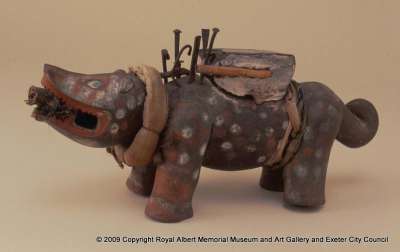Figure
This power figure (nkisi) is in the form of a dog, and would have been activated by an nganga, an operator of invisible forces. Due to its spots this carving was once believed to be a leopard. However, the colour white is associated with the ancestral world (mpenbe) and the spotting is concerned with the ability to cross into other worlds.
The box on its back, the cloth around its neck, and the cane in its mouth contain substances (bilongo) waiting to be activated - they could be medicinal. The nails in its back will have given the object power in sealing oaths, or in harming enemies. The reflective surface of the mirror is linked to light, protection, and water. Mirrors provided or denied access to invisible powers, and were separately used in acts of divination.
Dogs have keen senses, but in BaKongo culture, they were believed to have the ability to cross boundaries, such as the one between the human and ancestral worlds. Dogs are also hunters and could detect invisible trails, which is perfect if one was hunting witches. A dog nkisi could also be used to protect the home.
Collected by Hatton & Cookson trader Richard E. Dennett between 1879 and 1889.
L. 450 x W. 115 x H. 210 mm
The box on its back, the cloth around its neck, and the cane in its mouth contain substances (bilongo) waiting to be activated - they could be medicinal. The nails in its back will have given the object power in sealing oaths, or in harming enemies. The reflective surface of the mirror is linked to light, protection, and water. Mirrors provided or denied access to invisible powers, and were separately used in acts of divination.
Dogs have keen senses, but in BaKongo culture, they were believed to have the ability to cross boundaries, such as the one between the human and ancestral worlds. Dogs are also hunters and could detect invisible trails, which is perfect if one was hunting witches. A dog nkisi could also be used to protect the home.
Collected by Hatton & Cookson trader Richard E. Dennett between 1879 and 1889.
L. 450 x W. 115 x H. 210 mm
Object Summary
- Accession Loan No.
- 9/1889/57
- Category
- Ethnography
- Collection Class
- Religion and magic
- Collection Area Region
- Central Africa
- Collector Excavator
- Dennett, Mr Richard Edward (from the collection of)
- Material
- wood | cloth | glass | metal | pigments
- Common Name
- figure
- Simple Name
- power figure
- Production Town
- Loango
- Production County
- Lower Congo River
- Production Country
- Congo, Democratic Republic of
- Production Person Initials
- Production Person Surname
- Production Year Low
- Production Year High
- 1889


